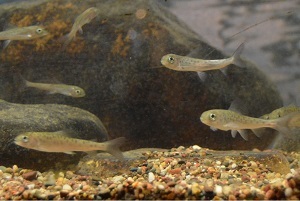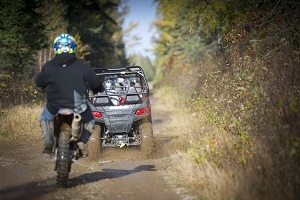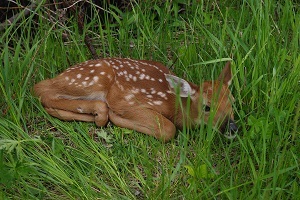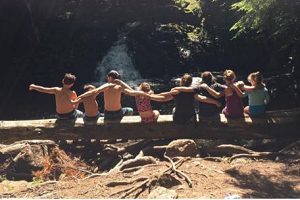|
Here's a look at some of this week's stories from the Michigan Department of Natural Resources:
See other news releases, Showcasing the DNR stories, photos and other resources at Michigan.gov/DNRPressRoom.
PHOTO FOLDER: Larger, higher-res versions of many of the images used in this digest, and others, are available in this folder.

Michigan’s plan to reintroduce Arctic grayling to state waters is taking a big leap forward, courtesy of some generous donors and partners.
Plans are under way to install an ultraviolet water disinfection system at the DNR’s Oden State Fish Hatchery in Emmet County. The system, which should be in place by mid-August, is critical for both cultivating Arctic grayling and other fish broodstock – mature fish used for breeding – and ensuring that waters receiving those fish are protected from potential pathogens (things that can cause disease).
“We are grateful for the outpouring of support to bring this upgrade to Oden State Fish Hatchery, where protecting water quality is key to sustaining healthy fisheries across the state,” said Ed Eisch, manager of the DNR Fish Production Program.
The state of Alaska is providing Michigan with three “year classes” of wild Arctic grayling eggs. A year class is a group of fish of the same species and strain that hatched in the same year. Michigan’s first year class of eggs was collected a week ago at the Ruth Barnett Sport Fish Hatchery in Fairbanks, Alaska, with fish caught out of the Chena River. The eggs were collected by the Alaska Department of Fish and Game, with assistance from Michigan DNR staff. Michigan State University PhD candidate Nicole Watson will be bringing back enough eggs – roughly 10,000 – to run her second year of experiments and produce the state’s first year class of broodstock.
|

These eggs initially will be reared in isolation at the Oden hatchery. Once cleared by fish health testing, they’ll be transferred to Marquette State Fish Hatchery. During broodstock development, scientific evaluations will continue on the Manistee River and begin on the Jordan, Maple and Boardman rivers to determine suitability for reintroduction.
More than $350,000 was raised to upgrade Oden’s isolated rearing facility, including engineering and construction costs. Major gifts were granted by Henry E. and Consuelo S. Wenger Foundation, Little River Band of Ottawa Indians, Trout Unlimited, the DNR, Rosso Family Foundation, Petoskey-Harbor Springs Area Community Foundation, Oleson Foundation, Rotary Charities of Traverse City, Friends of the Jordan River Watershed and supporters of the Little Traverse Conservancy.
Learn more about the initiative at MiGrayling.org.
Questions? Contact Ed Eisch, 231-922-6055 or Archie Martell (Little River Band of Ottawa Indians), 231-398-2193.
|

Speed and reckless driving are the primary contributing factors for off-road vehicle accidents, with 24 percent of all ORV accidents reported in 2017 resulting from people driving too fast, and 16 percent of riders not wearing a helmet.
Michigan DNR conservation officers are seeing more ORVs hitting the trail earlier in the season. They're also seeing more accidents, which easily could be avoided by keeping safety in mind.
Most ORV accidents can be avoided by riding at a safe speed, riding sober, riding on the right side of the trail, easing up around corners, being familiar with the terrain and riding within the ORV’s limits.
“There may be designated ORV speed limits on public roadways approved for ORVs,” said Conservation Officer Ben Shively, who patrols Oceana County. “And while there are no posted speeds on trails, riders can receive a citation for excessive speed or reckless riding.”
It’s also important to wear a helmet and to remember that there are many ORVs on the trails, including a growing number of side-by-side vehicles.
|

“We want to remind riders to take corners easy and ride on the right side of the trail,” said Conservation Officer Josiah Killingbeck, who patrols Lake County. “Side-by-sides are wider than dirt bikes and quads, taking up more room on the trails. You never know what’s around the corner.”
Conservation officers are seeing a big increase in ORV users drinking and driving, according to Killingbeck.
“ORV riding is a great sport,” he said. “Families and youth are enjoying it – please be responsible and ride sober so everyone can continue to enjoy this sport.”
To learn more about ORV safety and rules or to view an interactive, printable map of state roads available for ORV use, go to Michigan.gov/ORVInfo or Michigan.gov/RideRight.
For more information, contact Cpl. John Morey, 989-732-3541.
|

It happens every spring. You're outside walking, enjoying the fresh air, blooming flowers and budding trees, when you spot it – a tawny, wide-eyed fawn, curled up in the grass. What should you do? Nothing.
In case you missed it, the DNR recently shared some information about this very scenario, including some facts about how deer care for and place their babies in seemingly "abandoned" areas:
A thicket, a patch of tall grass and a quiet spot in your back yard – all places that fawns have been found. For the first few weeks of a white-tailed deer fawn’s life, its mother will hide it in secluded locations. This behavior helps reduce the potential of predators finding the fawn.
While fawns may seem abandoned, they rarely are. All wild white-tailed deer begin life this way. Read the full story here.
|

A Michigan milestone, the 100-year anniversary of Michigan state parks, has arrived! On May 12, 1919, the state Legislature established the Michigan State Park Commission and gave it responsibility to oversee, acquire and maintain public lands – a critical step in the development of today’s state parks system.
Though the DNR encourages people to enjoy opportunities to celebrate all year long, park fans were invited to mark the moment by camping during the official May 10-12 anniversary weekend (and get a complimentary, commemorative state parks centennial bumper sticker).
While plenty of factors (like weather) affect spring campground occupancy, more than a quarter of all campsites were booked this past weekend, and several state parks were very busy: Algonac (86% occupancy), Brighton (64%), Hartwick Pines (77%), Holland (95%), Ludington (59%), Pinckney (65%), Seven Lakes (68%) and Sleepy Hollow (82%). Overall, state park campground occupancy was up 22% over the same weekend last year.
|

Beyond camping, many centennial programs and information resources are in place:
- A new partnership with Bob Ross Inc. renamed the state park tree-planting program Happy Little Trees, with upcoming planting dates.
- A special memory map is capturing state park memories and photos.
- Compelling historical stories recount state parks’ early years.
- Pure Michigan launched the first few tracks of Pure Michigan Sounds – a first-of-its-kind album blending ambient sounds recorded at state parks with music by Michigan artists.
- A number of centennial events will take place across the state this summer and fall, including a May 18 open house and scavenger hunt kickoff at Interlochen State Park geared toward families in the Grand Traverse region.
There’s lots more on the horizon. The Centennial GeoTour featuring 100 new caches kicks off May 24. The recently released, all-new Stamp & Go Guide helps visitors log their state park and hatchery visits. The campfire storytelling project invites visitors to hear seasoned storytellers and encourages everyone to share memories around a campfire.
Many other events – vintage camping shows, a race series and yoga – are set for summer and fall. Get all the centennial news you need to know at Michigan.gov/StateParks100.
|
|